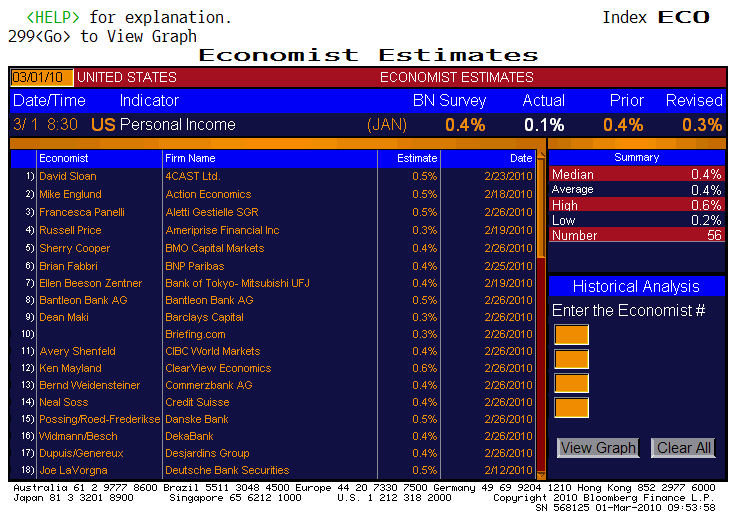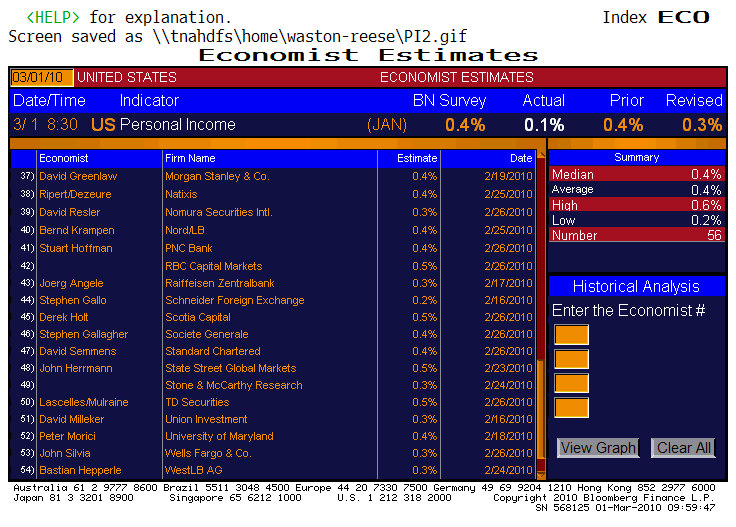United States News
See other United States News Articles
Title: U.S. Consumer Spending Increases More Than Forecast
Source:
Bloomberg
URL Source: http://www.bloomberg.com/apps/news? ... 0601087&sid=aH9O6gFU0qDQ&pos=2
Published: Mar 1, 2010
Author: Bloomberg
Post Date: 2010-03-01 09:29:11 by go65
Keywords: None
Views: 2354
Comments: 15
March 1 (Bloomberg) -- Spending by U.S. consumers increased in January for a fourth consecutive month, a sign that the biggest part of the economy may contribute more to growth in coming months. The 0.5 percent increase in purchases was more than anticipated and followed a 0.3 percent gain in December that was larger than previously estimated, Commerce Department figures showed today in Washington. Incomes climbed 0.1 percent, short of expectations and reflecting declines in dividends and interest. Retailers such as Home Depot Inc. and Macy’s Inc. are forecasting rising sales this year, even as they don’t foresee a robust economic recovery. An unemployment rate that’s projected to average 9.8 percent this year may restrain household purchases, which account for about 70 percent of the economy. “It’s a good start” for the year, said Brian Bethune, chief financial economist at IHS Global Insight in Lexington, Massachusetts, who correctly forecast the increase in purchases. Still, he said, “consumption is not going to be the driver” of economic growth. Stock-index futures maintained earlier gains following the report. The contract on the Standard & Poor’s 500 Index rose 0.4 percent to 1,107.7 at 9:05 a.m. in New York. Treasury securities were little changed. Exceeds Forecast The median estimate of 61 economists surveyed called for a 0.4 percent increase in spending, after an originally reported gain of 0.2 percent the prior month. Projections ranged from gains of 0.2 percent to 0.6 percent. The increase in incomes followed a 0.3 percent advance in December. The median forecast of economists surveyed anticipated a 0.4 percent gain. Wages and salaries climbed 0.4 percent in January, the most since April, after increasing 0.1 percent the prior month. Interest payments fell 0.3 percent while dividends declined 3 percent. Disposable income, or the money left over after taxes, dropped 0.4 percent, the largest decrease since July, reflecting an increase in federal non-withheld income taxes. Today’s report showed stable prices. The inflation gauge tied to spending patterns rose 2.1 percent from January 2009, less than the 2.2 percent survey median forecast. The Federal Reserve’s preferred price measure, which excludes food and fuel, was unchanged in January from the previous month and was up 1.4 percent from a year earlier. Adjusted for inflation, spending climbed 0.3 percent following a 0.1 percent rise the prior month. Because the increase in spending was larger than the gain in incomes, the savings rate fell to 3.3 percent, the lowest level since October 2008, from 4.2 percent the prior month. Broad-Based Gains Inflation-adjusted spending on durable goods, such as autos, furniture, and other long-lasting items, climbed 0.7 percent in January after rising 0.6 percent the prior month. Purchases of non-durable goods increased 0.8 percent, and spending on services, which account for almost 60 percent of all outlays, increased 0.1 percent. The economy grew at a 5.9 percent annual rate in the fourth quarter, the fastest pace in six years, figures from the Commerce Department showed last week. Consumer spending slowed to a 1.7 percent pace, from 2.8 percent the previous three months. Home Depot is among companies projecting stronger sales. “We recognize that we have more work to do as a company and that the economy is not out of the woods yet, particularly in our market, so we’re not projecting robust growth,” Home Depot Chairman and Chief Executive Officer Frank Blake said on a Feb. 23 conference call with analysts. To contact the reporter on this story: Timothy R. Homan in Washington at thoman1@bloomberg.net
Post Comment Private Reply Ignore Thread
Top • Page Up • Full Thread • Page Down • Bottom/Latest
#1. To: go65 (#0)
Wow, that's great news. I'm sure glad the recession's over. I guess that means you'll go back to posting endless polls pretty soon, huh?
Obammy sez it Based on forecasts by who?
my anti groupie can't get through life without me.
You're welcome, Boof...
Day 8 of Packrat refusing to register here. Day 6 Of Boofer The One Eyed Wonder Bot refusing to answer: When is Blackwell going to have the recount?
You're welcome. Boof...
Day 8 of Packrat refusing to register here. Day 6 Of Boofer The One Eyed Wonder Bot refusing to answer: When is Blackwell going to have the recount?
To contact the reporter on this story: Obammy sez it You're welcome, Boof
Day 8 of Packrat refusing to register here. Day 6 Of Boofer The One Eyed Wonder Bot refusing to answer: When is Blackwell going to have the recount?
(laughing)
my anti groupie can't get through life without me.
Homan is probably a Tea Bagger...fyi...Bob Willis DEFINITELY is...
Day 8 of Packrat refusing to register here. Day 6 Of Boofer The One Eyed Wonder Bot refusing to answer: When is Blackwell going to have the recount?
He left out the part of the story that showed real dispoisble income dropped in January by .6%. He's a bit selective in the news he likes to post, heh?
Goldi-Lox: You're one dumb-fucking bitch.
Hey how did Real disposible income do in January War?
Goldi-Lox: You're one dumb-fucking bitch.
I know, and every leftwinger is 'selective'. Thats why Margaret Sanger is one of the Left's hero's....
my anti groupie can't get through life without me.
Up .1. That's not the question that you wanted to ask. You wanted to ask what was CHAIN WEIGHTED blah blah blah... Real is a simple eqiation...Actual - Deflator = Real...
Day 8 of Packrat refusing to register here. Day 6 Of Boofer The One Eyed Wonder Bot refusing to answer: When is Blackwell going to have the recount?
Nope, down .6%. REAL. Not "unreal" or imaginary.
Goldi-Lox: You're one dumb-fucking bitch.
Up .1. That's not the question that you wanted to ask. You wanted to ask what was CHAIN WEIGHTED blah blah blah... Real is a simple eqiation...Actual - Deflator = Real... I expect better from you than that. Let's be intellectually honest here, it's the REAL value that matters and you know it.
Goldi-Lox: You're one dumb-fucking bitch.
Real was up .1. Chain weighted, which is pegged against a fixed time and averaged out over time as income sources change, was down...right now it's pegged back to the height of the housing boom so excuse me if I'm a bit jaded about the chain weighted index right now.
Day 8 of Packrat refusing to register here. Day 6 Of Boofer The One Eyed Wonder Bot refusing to answer: When is Blackwell going to have the recount?
I believes it
an' that settles it!
#2. To: go65 (#0)
#3. To: Badeye (#2)
(Edited)
Based on forecasts by who [sic]?

#4. To: Badeye (#2)

#5. To: go65 (#0)
To contact the reporter on this story: Timothy R. Homan in Washington at thoman1@bloomberg.net
Timothy R. Homan in Washington at thoman1@bloomberg.net tooth.fairy@whitehouseshill.gov
I believes it
an' that settles it!
#6. To: Badeye (#2)

#7. To: Get Outta Dodge! (#5)
#8. To: Get Outta Dodge! (#5)
#9. To: Badeye, Go65 (#2)
#10. To: war (#6)
#11. To: Nebuchadnezzar (#9)
#12. To: Nebuchadnezzar (#10)
Hey how did Real disposible income do in January War?
#13. To: war (#12)
#14. To: war (#12)
Hey how did Real disposible income do in January War?
#15. To: Nebuchadnezzar (#14)
(Edited)
Top • Page Up • Full Thread • Page Down • Bottom/Latest
[Home] [Headlines] [Latest Articles] [Latest Comments] [Post] [Mail] [Sign-in] [Setup] [Help] [Register]
